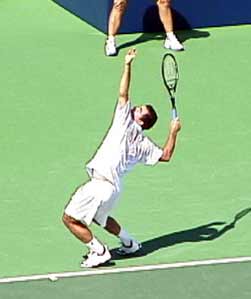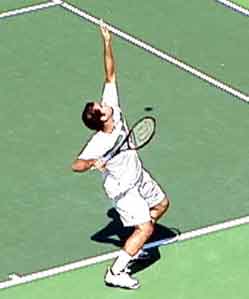<% ns_puts [mkm_getnavbar] %>

Advanced Tennis: Sampras Serve Developing Advanced Footwork
by John Yandell
Page 2 |
The Coil
Watch the start of Peteís serve in the animation. He begins with his front foot raised. Donít be distracted by that raised foot. Thatís idiosyncratic - a personal, stylistic touch in Peteís motion that has nothing to do with his core bio-mechanics. Recently, I was in an elevator with a woman at a tennis club who was
|
Note: As Peteís arms drop, he lowers the front foot
until it's flat on the court. Then,
as he releases the ball, his weight begins to fall deeply onto the front
leg.
Try it like Pete if you absolutely must, but, the
simplest starting stance is with both feet already flat on the court and
your weight evenly balanced. The key is the shifting of the weight to the
front foot, the knee bend, and the timing of this shift.
The shift starts as the tossing arm begins to extend, but after the
actual release of the ball.
Note how deeply Pete is able to bend that front leg! At the bottom of the bend, his upper leg may be at something close to a 45 degree angle to the court. At the deepest point heís come up somewhat on his back toes, is well balanced and in control of his body weight.
 |
 |
Two views of Peteís full knee bend. His upper leg is close to 45 degrees to the court. Note that the torso stays in line. There is no back arch, his entire body inclines naturally due to the knee bend. |
|
Pete has NOT leaned forward or back at the waist. A common misperception is that great servers arch their backs during the wind up. In reality, Peteís torso stays in line from hips to <% ns_puts [nsv_get mkm_includes mkm_oldContentFooter_inc] %>

